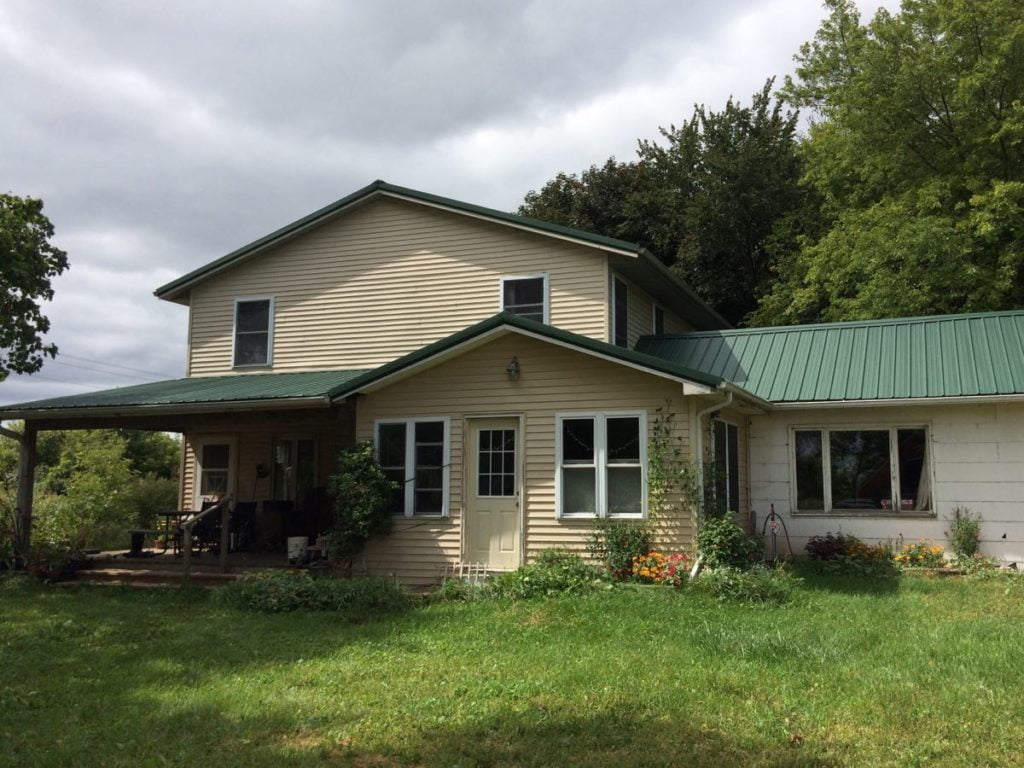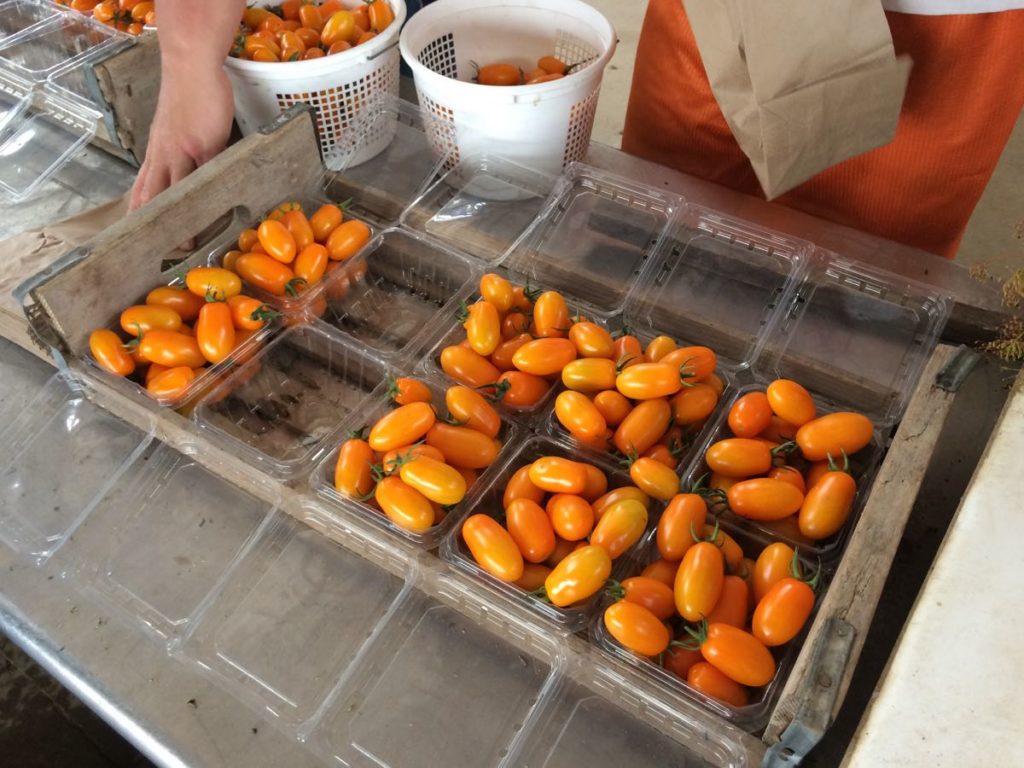Week #16, Farm landscape vernacular
- On: September 04, 2019
 0
0
We had our house re-roofed this year. The material choice was easy. Metal roofs last for a long time, and avoid landfill-clogging asphalt shingles. The color required thought. Red, to harmonize with our cream yellow siding? No, we have plenty of red farm buildings. Golden brown? Too dull. Deep purple? I would love that but we couldn’t get metal roofing in purple. We settled on forest green, a look that I treasure, maybe because the first farmhouse Steve and I shared was white with a green roof.
I didn’t think about the emotional tug of this color combination until making this decision. There’s a “vernacular” in the Wisconsin farm landscape. The classic look is a light-colored farmhouse with a green roof, paired with red barns. That’s what we have! We’re not comformists, we’re not bound by tradition. We just love this class Midwestern look. It’s nice in the summer when surrounded by green fields but really stands out in winter. In a white snow-covered landscape, the colorful buildings beckon as ‘home.’
We hired the Amish carpenters who built our pack shed. I asked Raymond if they could re-roof our house. He said, “Oh Beth, it’s going to be a year.” We waited. They’re in demand because they do a good job. This younger crew did not sing as they worked. The older crew who built our pack shed sang while they worked, and their music changed as they built the building around themselves. It was a delight. Beth
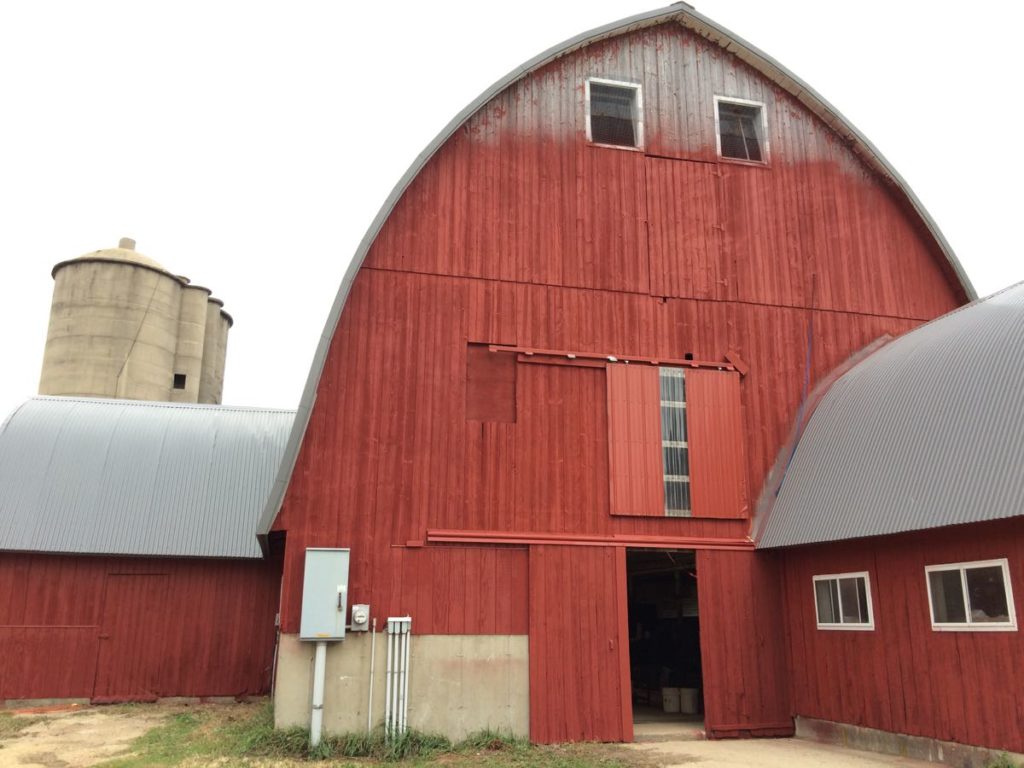
Our big red barn. We couldn’t reach the peak with our lift and paint wand. Drives me nuts.
Grape tomatoes in paper bags
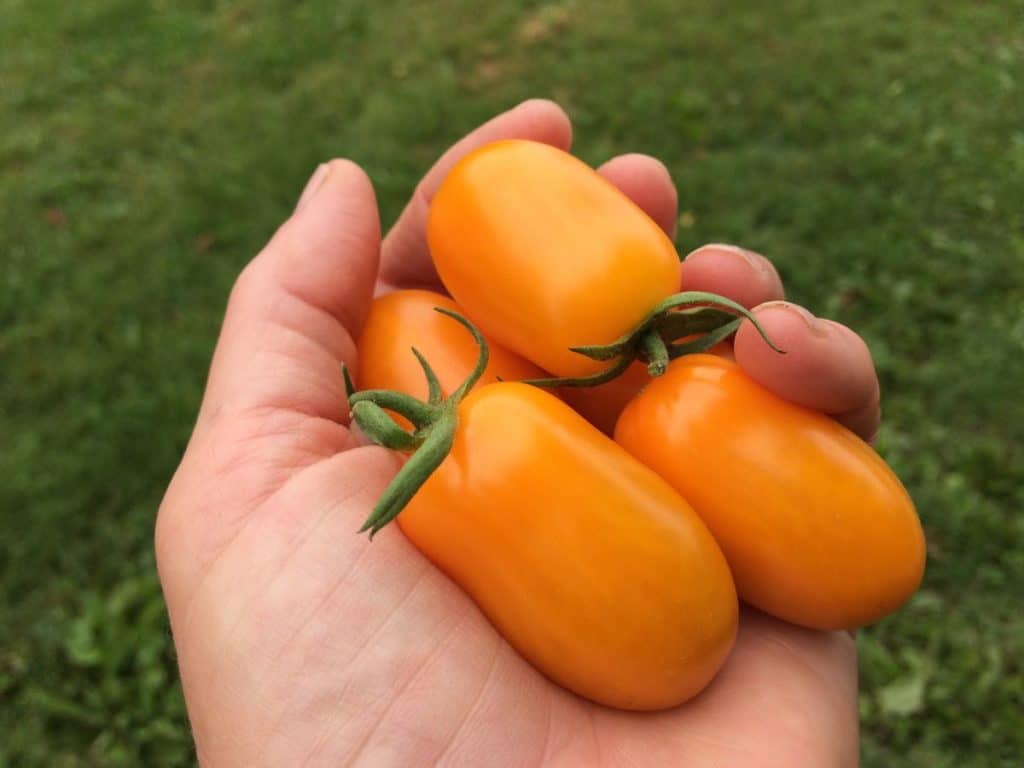
The ‘Nova’ orange grape tomatoes are really, really good.
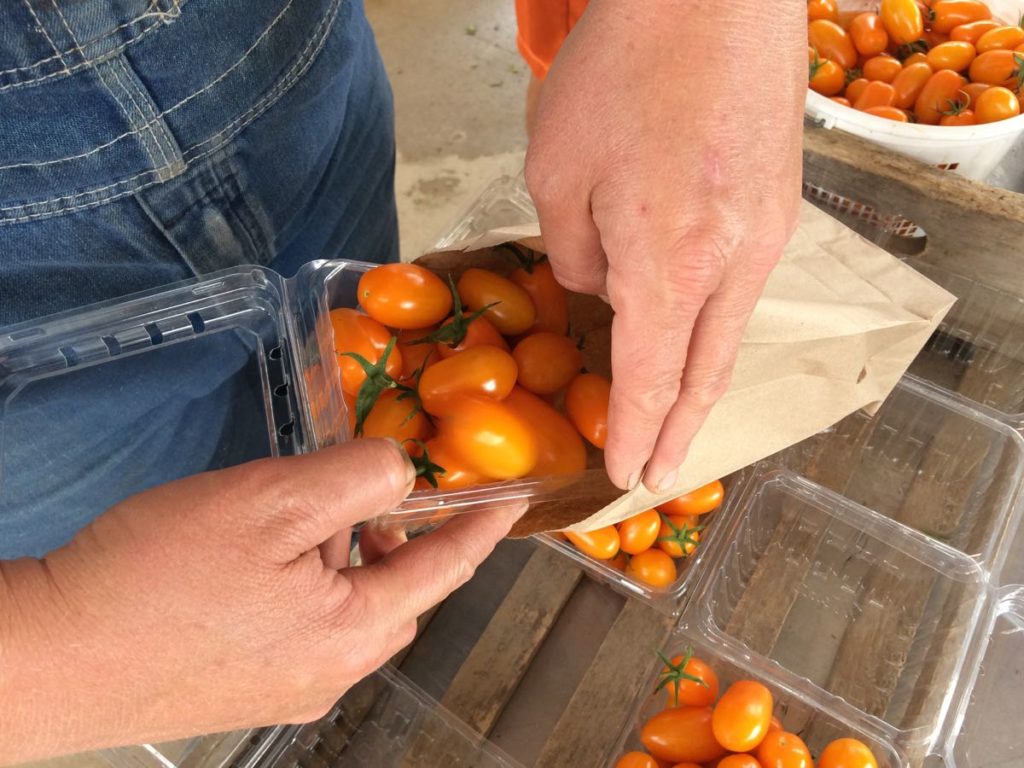
We continue trying to reduce plastic use, so we’re sending your grape tomatoes in a paper bag. Why use a plastic clamshell if we can use a paper bag instead? Watch out, these small bags are thin. You’ll probably want to transfer the tomatoes to a container once home. The Romano beans are in a paper bag again too.
I asked a few weeks ago if beans in paper bags worked OK, and only got positive replies. It’s been an easy switch. We will have to return to plastic bags for heavy root crops (carrots, beets, etc) that will blow out the bottom of a paper bag. In the meantime, we’ll keep using paper bags whenever we can. Could you all let me know if they are problematic with any of the crops? Beth
Veggie List and Veggie Notes
Week #16, Sept 5/6, 2019
– Weekly shares
– EOW/ green
Red watermelon
Slicing tomatoes, ~5 lb total
Romano beans, 1.7 lb
Edamame soybeans, 1 bundle
Kale, 1 medium bunch
Orange grape tomatoes, 1 pt in paper bag
Green bell pepper, 1
Colored bell pepper, 1
Orano snack pepper or yellow pepper, 1
Cucumber, 1 – 2
Walla Walla onion
Garlic, 1 bulb
Fresh dill seed
Next week’s box will probably contain tomatoes, peppers, onions, carrots, edamame and more.
Slicing tomatoes – The plants are mostly healthy, so the tomatoes should be OK stored on your kitchen counter. Take them out of the bag so you can keep an eye on them. Be strategic; use the ripest tomatoes first, or any that develop flaws. Store slicing tomatoes resting on their shoulders, with the stem side down. Plum tomatoes can be stored in any direction.
Romano beans – Romano beans are more robust and meaty than green beans. They are excellent raw but really shine when gently cooked for a long time. Pat has some good recipes below. I notice that most people who love Romano beans are dedicated to a particular recipe. Here are a few recommendations:
– Lauren asked me to remind you about last year’s African Peanut Stew recipe, which is easily adapted for this week’s veggies. It’s an excellent dish for this time of year.
– Former Tipi crew member Jon Fagan raves about Braised Green Beans with Tomato and Fennel Seeds (in previous newsletter, scroll down).
– My favorite Romano bean recipe (which I recommend every year but also look forward to every year!) is Sausages and Summer Beans with Tomatoes & Caramelized Onions.
– Finally, here’s a 2017 quote from Tipi member Steve Rankin:
“You have finally sold me. I have never been a fan of Romano beans. This week I have been sautéing them with various peppers and garlic, as well as the oregano from earlier this season. They are especially tasty with poblanos. Lots of black pepper and some soy sauce, which make the pan sticky. I deglaze the pan with wine and braise them in the wine. I’m sold!”
Edamame soybeans (bundle of green stems with pods attached) – These edible soybeans are a treat. Pull the pods from the stem and wash well. It helps to submerge the pods and rub them together. Boil in water until the pods have split and the beans are quite tender. Season with salt and pop the beans out of the pods into your mouth.
Storage: Remove the pods from the stems promptly and refrigerate.
Fresh dill seed – We’re sending the dill to use with the Romano beans. They are dill seed umbels. The seeds are young, not dried. You can use them to make a batch of refrigerator pickled beans or in a different bean dish. Dill is also good in tomato soup.
Preparation: Use the intact head when making pickles. When cooking, strip the seeds from the umbel. Lay on a cutting board. Crush with the flat side of a large knife, to release the flavor.
Storage: Refrigerate.
RECIPES
Visit our 2019 Recipe Log or our 2018 Recipe Log or join our Facebook discussion group.
LOCAL THYME/ Comforting Classics
Romano Beans with Walnuts and Dijon Dressing
Summer Wind Roasted Tomato Sauce
Garlicky Greens and Cranberry Beans
Niçoise Salad Chickpea Bowl
LOCAL THYME/ Outside the Box Recipes
Dilly Beans
Kale, Tomato, Three Cheese Galette
Tomato Cucumber Salad with Watermelon Vinaigrette
Watermelon and Pepper Salsa with Sriracha
LOCAL THYME/ Quick & Easy Meal
Watermelon Gazpacho
????????????
RECIPES FROM LAUREN
KALE SESAME GRAIN BOWL
Takes 40 minutes.
Serves 4-6.
1 cup salted water
1/4 cup quiona
1/4 cup favorite quick cooking rice (can also use a full 1/2 cup of either if you prefer)
1 bundle edamame soybeans, pods removed from stalks
1 pound romano beans, ends trimmed and cut into 1-inch pieces
5 garlic cloves, minced
1 orano pepper, minced
2 tablespoons rice wine vinegar
2 tablespoons peanut butter
2 tablespoons soy sauce or tamari
1 tablespoon maple syrup
3 tablespoons olive oi
1 tablespoon toasted sesame oil
1 bunch kale, stems removed and thinly sliced
1 cucumber, seeds removed and cut into small pieces
1 cup peanuts, roughly chopped
2 tablespoons white and/or black sesame seeds
- Bring 1 cup salted water to a boil in a small stock pot. Once boiling, add quinoa and rice. Reduce to a simmer, cover and cook for 18 minutes. After that remove from heat, cover the pot with a thin towel and then re-cover for 10 minutes.
- Bring a large pot of water to a boil over high heat. Once boiling, add edamame . Cook for 5 minutes and then rinse under cold water. Once cool enough to handle, remove the edamame from the shells. Set aside.
- Bring the pot back up to boiling and then add romano beans. Cook for 4 minutes and then rinse under cold water.
- In a small bowl, whisk together garlic, orano, vinegar, peanut butter, soy sauce, and maple syrup until smooth. Gently whisk in olive and sesame oils until dressing comes together. Taste and adjust flavors as desired.
- Toss kale, cucumber, quinoa, rice, edamame and romano beans together in a large bowl with half the dressing. Serve in smaller bowls topped with peanuts and sesame seeds.
.


